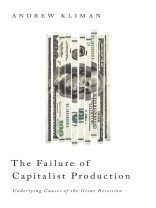The recent financial crisis and Great Recession have been analysed endlessly in the mainstream and academia, but this is the first book to conclude, on the basis of in-depth analyses of official US data, that Marx’s crisis theory can explain these events.
Marx believed that the rate of profit has a tendency to fall, leading to economic crises and recessions. Many economists, Marxists among them, have dismissed this theory out of hand, but Andrew Kliman’s careful data analysis shows that the rate of profit did indeed decline after the post-World War II boom and that free-market policies failed to reverse the decline. The fall in profitability led to sluggish investment and economic growth, mounting debt problems, desperate attempts of governments to fight these problems by piling up even more debt – and ultimately to the Great Recession.
Kliman’s conclusion is simple but shocking: short of socialist transformation, the only way to escape the ‘new normal’ of a stagnant, crisis-prone economy is to restore profitability through full-scale destruction of existing wealth, something not seen since the Depression of the 1930s.
Tabela de Conteúdo
Acknowledgements
List of Abbreviations
List of Tables
List of Figures
1. Introduction
2. Profitability, the Credit System, and the “Destruction of Capital”
3. Double, Double, Toil and Trouble: Dot-com boom and home-price bubble
4. The 1970s––Not the 1980s––as Turning Point
5. Falling Rates of Profit and Accumulation
6. The Current-cost “Rate of Profit”
7. Why the Rate of Profit Fell
8. The Underconsumptionist Alternative
9. What Is to Be Undone?
Bibliography
Index
Sobre o autor
Andrew Kliman is Professor of Economics at Pace University, New York. He is the author of Reclaiming Marx’s ‘Capital’ (Lexington, 2006 ) and The Failure of Capitalist Production (Pluto, 2011).












